
Introduction
An abscess is a localized infection that results in a pocket of pus forming within the body. In dogs, abscesses can occur on the skin or internally, often caused by bacteria that enter the body through a break in the skin, a bite, or from foreign objects. The formation of an abscess is the body’s response to infection, where white blood cells rush to the area to fight off invading pathogens, leading to the accumulation of pus.
Common Causes
Understanding the common causes of abscesses in dogs can help pet owners take preventive measures. Abscesses frequently occur due to:
- Bite wounds: When dogs fight or interact with other animals, bites can introduce bacteria.
- Foreign objects: Splinters or thorns that penetrate the skin may lead to infection.
- Infections: Conditions like dental disease can also cause abscesses in the gums.
Timely treatment of an abscess is critical. If left untreated, abscesses can become more severe, leading to systemic infections that may require more intensive medical intervention.
Understanding Abscesses in Dogs
Types of Abscesses
Abscesses in dogs can be categorized into two main types:
-
Skin Abscess: These are the most common type and occur just beneath the skin. They often present as swollen, painful lumps and are frequently caused by bite wounds, trauma, or foreign objects.
-
Internal Abscess: These occur within the body and can be more challenging to diagnose. Symptoms might include fever, lethargy, vomiting, or loss of appetite, depending on the location and severity.
Identification of Symptoms
Recognizing the symptoms of an abscess is essential for prompt treatment. Common physical signs include:
- Swelling and redness around the affected area.
- Heat emanating from the abscess site.
- A noticeable lump that may feel soft or fluctuant.
Behavioral changes can also indicate an abscess:
- Pain responses: Dogs may whine, yelp, or become aggressive when the area is touched.
- Lethargy: A dog may become less active and prefer to lie down.
- Loss of appetite: If a dog is in pain, it may refuse to eat.
Knowing when to seek veterinary care is crucial. If you notice any of the following, it’s time to consult a vet:
- Increased swelling or the presence of pus.
- Persistent pain or discomfort.
- Signs of systemic infection, such as fever.
At-Home Treatment Options
Initial Assessment
Before treating an abscess at home, it’s vital to evaluate the abscess. Consider the following:
- Size: Is it small and manageable, or larger and more concerning?
- Location: Is it on a sensitive area, like the face or near joints?
- Severity: Is there significant pain or systemic symptoms?
Once you assess the situation, gather the necessary supplies, including:
- Antiseptics (like hydrogen peroxide or saline solution)
- Sterile bandages or gauze
- Tweezers (for debris removal)
- Clean cloths or cotton pads
Cleaning the Abscess
Cleaning the abscess properly is a critical step. Here’s a step-by-step cleaning process:
- Wash your hands thoroughly to prevent introducing more bacteria.
- Gently shave or trim the fur around the abscess if necessary (be cautious).
- Use saline solution or antiseptic to clean the area. Apply it with a clean cloth or cotton pad.
- Pat the area dry with a clean towel.
- Inspect the abscess for foreign material or debris.
Recommended Cleaning Solutions
For cleaning the abscess, opt for safe antiseptics like:
- Diluted hydrogen peroxide (1 part hydrogen peroxide to 3 parts water)
- Saline solution (can be purchased or made at home)
- Antiseptic wipes designed for pets
Drainage Techniques
In some cases, drainage may be necessary. Here’s how to know when to consider drainage:
- The abscess is large and painful.
- It appears ready to burst, with pus accumulating.
How to Drain an Abscess at Home
If you feel confident and the abscess is on the skin, follow these steps:
- Prepare your tools: Sterilize a needle or scalpel with alcohol.
- Clean the area: As described above.
- Make a small incision at the lowest point of the abscess to allow pus to escape.
- Gently squeeze the area to encourage drainage.
- Clean the area again after the pus has drained.
- Apply a clean bandage to protect the area.
Warning Against DIY Drainage: Draining an abscess at home carries risks. If unsure, it’s better to err on the side of caution and seek veterinary advice. Improper drainage can lead to further infection or complications.
Pain Management
Pain management is essential for your dog’s comfort. Here are over-the-counter options:
- Aspirin: Consult your vet for the appropriate dosage.
- Acetaminophen: This is not safe for dogs and should be avoided.
- Ibuprofen: Also not safe and should be avoided.
Natural Remedies
Natural pain relief methods can also provide comfort, such as:
- Turmeric: Known for its anti-inflammatory properties.
- Coconut oil: Can soothe skin irritations.
- Herbal treatments: Always consult your vet before administering any herbal remedies.
Post-Treatment Care
Monitoring the Healing Process
After treatment, it’s crucial to monitor the healing process. Look for:
- Signs of improvement: Reduced swelling, less pain, and gradual healing.
- Signs of complications: If swelling increases, there’s drainage of foul-smelling pus, or your dog shows signs of fever, consult your veterinarian.
Bandaging and Protecting the Area
Proper bandaging is essential to keep the area clean and protected. Here’s how to properly bandage the abscess:
- Apply a sterile pad directly over the wound.
- Wrap a bandage around the area, ensuring it’s snug but not too tight.
- Secure the bandage with medical tape, avoiding any sticking to the fur.
To prevent your dog from licking or scratching, consider these tips:
- Use an Elizabethan collar (cone) to prevent access.
- Keep the area clean and check the bandage regularly.
When to Seek Veterinary Care
Indicators for Immediate Attention
Certain signs indicate the need for immediate veterinary care:
- Symptoms of infection: Fever, increased swelling, and pus that smells foul.
- Behavioral changes: If your dog appears to be in persistent pain, refuses to eat, or exhibits unusual behaviors, contact your vet.
Importance of Professional Follow-Up
Professional follow-up is crucial to prevent complications. If left untreated, abscesses can lead to:
- Systemic infections: Bacteria can spread to other body parts.
- Chronic issues: Recurrent abscesses may develop if the underlying cause isn’t addressed.
During a veterinary visit, expect an examination, possible drainage, and treatment options tailored to your dog’s needs.
Conclusion
Treating an abscess on your dog at home can be effective with the right knowledge and precautions. Always assess the situation carefully, clean the area properly, and monitor for any signs of complications. Responsible pet ownership includes regular veterinary check-ups and being proactive about your pet’s health. If in doubt, consulting a veterinarian ensures your dog receives the best care possible.
FAQs
Can I treat my dog’s abscess at home?
Yes, minor skin abscesses can be treated at home with proper cleaning and care. However, if the abscess is severe or internal, professional veterinary care is necessary.
What happens if an abscess bursts?
If an abscess bursts, it can release pus and bacteria, which may lead to further infection. Clean the area immediately and monitor for signs of infection.
Are there specific breeds more prone to abscesses?
While any breed can develop abscesses, certain breeds prone to skin conditions or those that are more active and prone to fights may be at higher risk.
How long does it take for an abscess to heal?
Healing time varies depending on the severity and treatment method but typically ranges from a few days to a couple of weeks.
Can abscesses lead to more serious conditions?
Yes, untreated abscesses can lead to systemic infections, chronic pain, or other severe complications, emphasizing the importance of prompt treatment.









